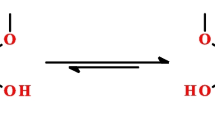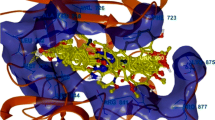Abstract
Curcumin exhibits a great ability in various biological and pharmacological activities. Evaluation of curcumin derivatives served to establish the three-dimensional quantitative structure–activity relationship (3D-QSAR) model which was validated by the evaluation of a serial of 22 compounds. Two favorable 3D-QSAR models (CoMFA with q 2 = 0.539, R 2 = 0.981; CoMSIA with q 2 = 0.451, R 2 = 0.907) had been developed to predict the biological activity of curcumin derivatives, and external metric q 2pred (CoMFA with 0.79; CoMSIA with 0.78) and r 2 m (overall) (CoMFA with 0.71; CoMSIA with 0.56) were applied to evaluate the ability of prediction. Comparing the results obtained from both standard models, we found that reducing the carbon chains of curcumin (S2 and A1 zones) could increase its MCF-7 cytotoxicity; exchanging acceptor/donor substituent on A2 and A4, A3 and D3 zones could turnover its cytotoxicity of MCF-7. These results help with understanding the specific activity of curcumin compounds and designing new specific MCF-7 inhibitors.




Similar content being viewed by others
References
Bheemanapalli LN, Kaur A, Arora RS, Akkinepally RR, Javali NM (2012) Synthesis, evaluation of 6,8-dibromo-2-aryl-2,3-dihydroquinolin-4(1H)-ones in MCF-7 (breast cancer) cell lines and their docking studies. Med Chem Res 21:1741–1750
Chen Q-Y, Zheng Y, Jiao D-M, Chen F-Y, Hu H-Z, Wu Y-Q, Song J, Yan J, Wu L-J, Lv G-Y (2014) Curcumin inhibits lung cancer cell migration and invasion through Rac1-dependent signaling pathway. J Nutr Biochem 25:177–185
Dubey SK, Sharma AK, Narain U, Misra K, Pati U (2008) Design, synthesis and characterization of some bioactive conjugates of curcumin with glycine, glutamic acid, valine and demethylenated piperic acid and study of their antimicrobial and antiproliferative properties. Eur J Med Chem 43:1837–1846
Fang X, Fang L, Gou S, Cheng L (2013) Design and synthesis of dimethyl aminomethyl-substituted curcumin derivatives/analogues: potent antitumor and antioxidant activity, improved stability and aqueous solubility compared with curcumin. Bioorg Med Chem Lett 23:1297–1301
Fuchs JR, Bulbul P, Bhasin D, Etter JP, Regan N, Abdelhamid D, Li C, Lin J, Li P-K (2009) Structure–activity relationship studies of curcumin analogues. Bioorg Med Chem Lett 19:2065–2069
Karthikeyan NS, Sathiyanarayanan KI, Aravindan PG, Giridharan P (2011) Synthesis, crystal structure, and anticancer properties of cyclic monocarbonyl analogs of curcumin. Med Chem Res 20:81–87
Ke Z, Lu T, Liu H, Yuan H, Ran T, Zhang Y, Yao S, Xu J, Xu A, Chen Y (2014) 3D-QSAR and molecular fragment replacement study on diaminopyrimidine and pyrrolotriazine ALK inhibitors. J Mol Struct 1067:127–137
Kirschner KN, Lexa KW, Salisburg AM, Alser KA, Leroy J, Andersen TT, Bennett JA, Jacobson HI, Shields GC (2007) Computational design and experimental discovery of an antiestrogenic peptide derived from α-fetoprotein. J Am Chem Soc 129:6263–6268
Lee K-H, Aziz FHA, Syahida A, Abas F, Shaari K, Israf DA, Lajis NH (2009) Synthesis and biological evaluation of curcumin-like diarylpentanoid analogues for anti-inflammatory, antioxidant and anti-tyrosinase activities. Eur J Med Chem 44:3195–3200
Ojha PK, Mitra I, Das RN, Roy K (2011) Further exploring r 2 m Metrics for validation of QSPR models. Chemometr Intell Lab Syst 107:194–205
Parvathy KS, Negi PS, Srinivas P (2009) Antioxidant, antimutagenic and antibacterial activities of curcumin-β-diglucoside. Food Chem 115:265–271
Pratim Roy P, Paul S, Mitra I, Roy K (2009) On two novel parameters for validation of predictive QSAR models. Molecules 14:1660–1701
Roy K, Mitra I, Kar S, Ojha PK, Das RN, Kabir H (2012) Comparative studies on some metrics for external validation of QSPR models. J Chem Inf Model 52:396–408
Simon A, Allais DP, Duroux JL, Basly JP, Durand-Fontanier S, Delage C (1998) Inhibitory effect of curcuminoids on MCF-7 cell proliferation and structure–activity relationships. Cancer Lett 129:111–116
Yen T-Y, Macher BA, McDonald CA, Chris A-C, Timpe LC (2012) Glycoprotein profiles of human breast cells demonstrate a clear clustering of normal/benign versus malignant cell lines and basal versus luminal cell lines. J Proteome Res 11:656–667
Yuan M, Luo M, Song Y, Xu Q, Wang X, Cao Y, Bu X, Ren Y, Hua X (2011) Identification of curcumin derivatives as human glyoxalase I inhibitors: a combination of biological evaluation, molecular docking, 3D-QSAR and molecular dynamics simulation studies. Bioorg Med Chem 19:1189–1196
Acknowledgments
This research was supported by Youth Science Foundation of Guangxi Medical University (GXMUYSF201327).
Author information
Authors and Affiliations
Corresponding author
Rights and permissions
About this article
Cite this article
Wu, Z., Lan, Xb. & Jiang, Wz. 3D-QSAR research of curcumin derivatives. Med Chem Res 24, 3460–3466 (2015). https://doi.org/10.1007/s00044-015-1406-9
Received:
Accepted:
Published:
Issue Date:
DOI: https://doi.org/10.1007/s00044-015-1406-9




